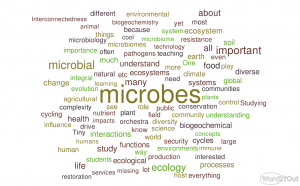Microbial Ecology Section

Word cloud from statements on microbial ecology generated at the virtual ME Section mixer during the 2020 ESA annual e-meeting
The Microbial Ecology Section of ESA supports ecologists who work with microbes and related microbial processes as their subjects of interest. We ask the same sort of ecological questions that would intrigue a plant or animal ecologist, and we work in ecosystems as varied as deep ocean hydrothermal vents and the interior of the human gut, and get as dirty as any other field ecologist. Our section supports microbial ecologists by providing student travel scholarships, facilitating interactions between microbial ecologists at the annual ESA meetings, through microbial outreach, and through posting job and funding opportunities
Mission Statement
The purpose of the Microbial Ecology Section is to promote research and education regarding the ecology of microorganisms. This shall include:
- Encouragement of research regarding the ecology of bacteria, archaea, microeukarya, and viruses
- Sponsorship of meetings concerning such research
- Promotion of the integration of microbial ecology into the general study of ecology
- Education of scientists and the general public regarding the pivotal role microorganisms play in ecological systems.
The Microbial Ecology Section is governed by ESA bylaws.
2023-2024 Officers
- Lily Khadempour, Section Chair
- Sneha Couvillion, Section Vice Chair
- Matthew Ogwu, Section Secretary
- Sarah Cuprewich, Student Representative
- Priscilla San Juan, DEI representative
- Pacifica Sommers, Industry Representative
- Jakob Jaochin, Social Media Representative
- Adriana L. Romero-Olivares, Past Section Chair
- Ex-officio leadership members: Naupaka Zimmerman, Mario Muscarella, Ariane L. Peralta
Click here for a list of past officers of the Microbial Ecology section.
Membership
If you are an ecological or environmental microbiologist, we hope you will consider joining the Ecological Society of America and our section. To join us, fill out the membership form located on the ESA Membership site and scroll down to “V.Section Affiliation” and select “Microbial Ecology Section”. Annual section membership dues are $5. You may join us at any time: ESA memberships run January to December, regardless of when you join. We also hope that some of you will consider submitting your manuscripts to ESA Journals or other ecological publications as an alternative to the strictly microbiological literature.
Microbial Ecology (ME) Section Leadership Roles
ESA ME Student Rep | Student Rep. Responsibilities: The student representative is a two-year position. The student rep serves as a liaison between us and the student section of ESA, so this person should be a member of both our section and the student section. They are expected to keep us informed about the student section activities and initiatives, and in turn to inform the student section about our call for student travel award applications and other microbial news that is relevant for students.
ESA ME Diversity, Equity, Inclusion Rep | DEI Rep. Responsibilities: The diversity rep is a two-year position. The diversity rep will assist the section with three major goals: (1) discussing procedures for ensuring diversity is being considered in all section decisions and activities; (2) collecting data on diversity within ME section membership in collaboration with ESA and developing proactive measures for increasing diversity representation in section membership; and (3) assisting with developing a plan to recruit an additional diversity/equity rep for the ME section from outside the section (and perhaps outside ESA). You are also responsible for attending ~monthly virtual meetings with the other members of the Microbial Ecology section board. You will be joining our current DEI representative to help further equity and equality in the Microbial Ecology Section.
ESA ME Secretary | Secretary Responsibilities: The secretary will move into Vice-Chair and then Chair roles (3 year commitment). The secretary will work with the chair and vice chair to create member programming/activities; review applications for student travel awards; arrange information booths at annual meetings; manage the section budget; plan business meetings and mixers; and in general, promote microbial ecology within and outside ESA.